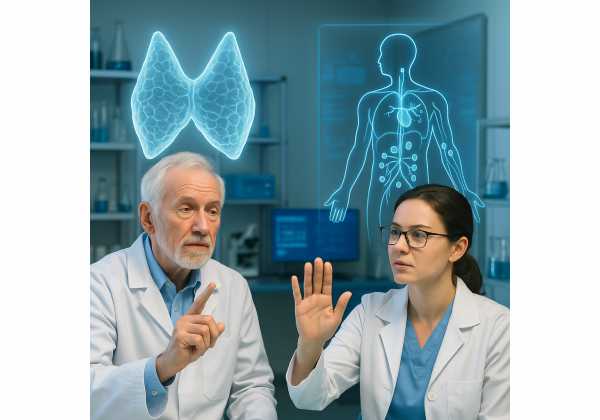
The thymus shapes our T-cell repertoire, the adaptive guard that recognizes new pathogens and tumor antigens. Yet this organ involutes early in adulthood: functional tissue thins, fat accumulates, and the flow of naïve T cells slows. Interest in reversing this trajectory has grown, with small human studies suggesting that targeted, multi-modal interventions might regenerate thymic tissue and nudge immune aging in a better direction. This article explains why thymic involution matters, what interventions are under consideration, what early human data show, and how to evaluate safety and outcomes. It also sketches a practical trial blueprint and a realistic way to integrate any thymus-directed strategy with basic preventive care. For readers mapping the larger field, a concise primer on the broader landscape of emerging longevity therapies provides helpful context.
Table of Contents
- Thymic Involution and Immune Aging: Why It Matters
- Intervention Concepts: Hormonal, Growth Factors, and Nutritional Context
- Signals from Early Human Studies and Limitations
- Safety: Glucose, IGF-1 Axis, and Neoplasia Concerns
- Outcome Measures: T-Cell Repertoires, Vaccination Response, and Infections
- Trial Design: Inclusion Criteria, Duration, and Follow-Up
- Integration with Lifestyle and Standard Preventive Care
Thymic Involution and Immune Aging: Why It Matters
By late adolescence, the thymus has already peaked. Over the next decades, thymic epithelial networks shrink and are replaced by adipose tissue. Output of recent thymic emigrants (new naïve T cells) drops, and the immune system compensates by expanding existing clones through homeostatic proliferation. That compensation maintains T-cell counts but not breadth. The result is a repertoire that gradually narrows, with more oligoclonal expansions and fewer truly new specificities to meet unfamiliar pathogens.
Why does this matter in daily life? First, a narrower repertoire can blunt responses to vaccines targeting novel or drifted antigens, forcing reliance on higher antigen doses or adjuvants. Second, fewer naïve T cells and more clonal memory skewing can impair coordination across helper and cytotoxic subsets during infections, contributing to prolonged illness and higher complication rates in older adults. Third, immune surveillance against cancer depends on continually generating fresh T-cell receptor (TCR) combinations that might recognize neoantigens; a shrinking repertoire raises the odds that precancerous cells slip through. Finally, thymic involution often walks in step with systemic “inflammaging”—low-grade chronic inflammation that correlates with frailty, cardiovascular risk, and metabolic disease.
Mechanistically, multiple inputs converge on the thymus. Sex steroids surge at puberty and suppress thymic epithelial cell (TEC) maintenance. Nutrient-sensing pathways (insulin, IGF-1, mTOR) modulate TEC proliferation and thymocyte selection. Stress, infections, and cytotoxic therapies accelerate atrophy. Microenvironmental cues—IL-7 availability, stromal extracellular matrix, and vascular support—govern whether thymopoiesis persists or stalls. Animal models show that some of these levers can be moved: reducing sex steroids, tweaking mTOR signaling, or delivering TEC-supporting factors can transiently increase thymic size and output. Translating those insights to humans is the challenge.
Clinically, thymic health is not a curiosity; it is a gatekeeper for immune resilience. People with robust naïve T-cell pools tend to maintain better responses to seasonal and pandemic vaccines, recover faster from acute infections, and show fewer opportunistic infections after chemotherapy or stem-cell transplantation. In older adults, even modest improvements in repertoire richness could translate into fewer hospitalizations across a winter season or better tumor control alongside immunotherapy. This is the promise behind attempts to regenerate or preserve the thymus: not “turning back the clock” in a generic sense, but restoring a specific organ function that underwrites immune adaptability.
Intervention Concepts: Hormonal, Growth Factors, and Nutritional Context
Most human-oriented thymus regeneration strategies pull on three categories of levers: hormonal modulation, growth-factor signaling, and nutritional or metabolic support. The leading concept combines targeted growth hormone (GH) pathway stimulation with insulin control and mild adrenal modulation, aiming to stimulate thymic epithelial turnover without provoking hyperglycemia or excessive IGF-1 exposure.
Hormonal modulation. Androgens suppress thymopoiesis; conversely, temporary sex-steroid reduction can enlarge the thymus in animals and post-chemotherapy settings. In community-dwelling older adults, routine sex-steroid ablation is not practical, but the principle highlights how endocrine tone shapes thymic biology. Adrenal hormones also matter: dehydroepiandrosterone (DHEA), a precursor that declines with age, may counteract some GH-induced insulin resistance and has context-dependent immune effects in small studies. Any hormone use demands careful monitoring for lipids, glucose, mood, and skin effects.
Growth factors. GH and its downstream effector IGF-1 can increase thymic mass and cellularity in animals, potentially by supporting TEC proliferation and thymocyte survival. In humans, GH raises concerns about glucose and mitogenic signaling, so the common design principle is “stimulate while constrained”: deliver enough GH activity to nudge thymic tissue but pair it with insulin-sensitizing measures (diet, metformin where appropriate) to avoid hyperglycemia, and target IGF-1 within age-appropriate ranges rather than supraphysiologic peaks. Interleukin-7 (IL-7) is an attractive TEC-thymocyte trophic factor; in early clinical contexts it expands naïve T cells, though reliable, durable thymic regeneration with IL-7 alone has not been established in healthy aging.
Nutritional and metabolic context. Thymopoiesis is metabolically expensive and sensitive to protein and micronutrient status. Protein adequacy (generally 1.0–1.2 g/kg/day for older adults unless restricted) supports lymphoid tissue turnover. Vitamin A and zinc are required for TEC integrity and T-cell development; vitamin D modulates thymocyte selection thresholds and peripheral inflammation. Glycemic control is central: hyperinsulinemia pushes IGF-1 activity and can degrade TEC function indirectly through inflammation. Exercise—especially moderate aerobic plus resistance work—improves insulin sensitivity, reduces visceral adiposity that secretes pro-inflammatory cytokines, and has been associated with larger naïve T-cell pools.
Adjacencies and stacks. Some protocols contemplate layering low-dose mTOR inhibition or other geroscience agents to broaden immune effects. That belongs in formal trials with predefined safety gates; outside research settings, restraint is prudent. For background on stacking frameworks, see this discussion of combination trial design and why mechanism overlap matters.
The unifying theme is not any single pill but a controlled, homeostasis-aware program: gently stimulate thymic growth pathways; prevent metabolic side effects; and provide the micronutrients and training environment for the organ to respond. Dosing, timing, and sequence are where the art—and the safety margin—live.
Signals from Early Human Studies and Limitations
A small, year-long pilot in healthy middle-aged men explored whether a three-part program—GH pathway stimulation, insulin mitigation, and DHEA—could regenerate thymic tissue and reverse certain age-associated immune trends. Several participants showed MRI evidence of thymic fat being replaced by tissue with the signal characteristics of lymphoid parenchyma. Peripheral blood markers suggested increased naïve T-cell fractions and changes consistent with lower immunosenescent burden. In parallel, epigenetic age estimates—derived from DNA methylation patterns—shifted in a younger direction across multiple clocks. These are encouraging signals, not definitive answers.
Why cautious optimism? First, the sample was small and demographically narrow. Nine volunteers cannot reveal rare adverse events, sex-specific effects, or interactions with common comorbidities. Second, imaging surrogates (fat-to-tissue replacement on MRI) are helpful but not proof of functional thymopoiesis; coupling imaging to recent thymic emigrant assays and TCR repertoire sequencing would strengthen the case. Third, methylation clocks summarize risk-associated patterns but are not clinical endpoints; they need alignment with hard outcomes such as vaccine responses, infection rates, and recovery trajectories after illness.
Subsequent pilot efforts have focused on expanding cohorts and refining personalization—tuning GH exposure, using insulin-sensitizing backstops, and adjusting DHEA based on androgenic side effects or lipid shifts. Key design upgrades include: pre-registration with clear primary endpoints (e.g., naïve T-cell gain measured by flow cytometry and sjTREC counts), blinded adjudication of imaging, and longer follow-up to test durability and rebound. Another priority is enrolling women and participants across broader racial and metabolic backgrounds to understand heterogeneity in response.
It is also important to separate thymus-specific effects from general health improvements. Weight loss, improved sleep, and increased physical activity—all common when people enroll in ambitious health programs—can lower inflammation and improve immune phenotypes on their own. Future studies should include lifestyle-matched control groups to isolate the thymic component. Finally, dose-finding work is essential: the goal is the minimal effective anabolic nudge, not chronic supraphysiologic signaling.
In short, early human data support biological plausibility and suggest measurable immune and epigenetic shifts over 9–12 months, but definitive evidence that such programs reduce infections, improve vaccine protection, or enhance cancer surveillance in diverse populations remains to be shown. This is precisely what larger, methodical trials must test. For readers exploring adjacent approaches that also aim to recalibrate aging biology via targeted signals, a brief overview of epigenetic reprogramming compounds outlines different mechanisms and trade-offs.
Safety: Glucose, IGF-1 Axis, and Neoplasia Concerns
Any strategy that leans on GH/IGF-1 biology demands rigorous guardrails. The core risks fall into three buckets: glycemic control, mitogenic signaling, and unmasking of latent disease.
Glucose and insulin. GH antagonizes insulin, raising hepatic glucose output and reducing peripheral uptake. In people with normal glucose tolerance, this may show up as higher fasting glucose and transient insulin resistance; in those with prediabetes, it can push hemoglobin A1c upward. Practical safeguards include baseline oral glucose tolerance testing or at least fasting glucose and A1c, paired with monthly monitoring early in therapy. Diet quality (fiber, unsaturated fats), protein timing, and structured exercise matter. Where clinically appropriate, an insulin-sensitizing agent can buffer GH’s metabolic effects. The objective is straightforward: preserve euglycemia throughout, and promptly de-escalate if glycemic markers drift.
IGF-1 targeting. IGF-1 is mitogenic and anti-apoptotic. Most clinicians aim to hold serum IGF-1 within age-adjusted reference ranges, avoiding sustained elevations. Monitoring every 6–8 weeks early on, then quarterly, allows dose adjustments. Thyroid function and cortisol dynamics should be checked as well, since both can influence GH/IGF-1 action and downstream metabolism.
Neoplasia. Does nudging the GH/IGF-1 axis increase cancer risk? Large replacement-therapy cohorts in GH-deficient patients—children and adults—suggest no meaningful increase in primary tumor incidence or recurrence when replacement targets physiologic ranges. That is reassuring but not definitive for otherwise healthy older adults receiving GH for a regenerative indication. The prudent posture is “oncology-first”: thorough baseline screening appropriate for age and sex; exclusion of anyone with active malignancy; and rapid evaluation of new symptoms (e.g., unexplained weight loss, focal pain). Family history and prior radiation exposure warrant extra caution. If IGF-1 cannot be kept in range without glycemic harm, stop.
Other safety items. Fluid retention, carpal tunnel symptoms, joint stiffness, and skin changes can occur. DHEA may affect mood, acne, and lipids; dose should be individualized or omitted in those sensitive to androgenic effects. Blood pressure should be tracked; sleep apnea screening is prudent in those with suggestive symptoms or high risk.
Data discipline. A pre-specified stopping rule protects participants: for example, any persistent A1c above a defined threshold, IGF-1 > upper limit of normal on two checks, or discovery of a suspicious lesion triggers discontinuation and evaluation. Safety is not the absence of adverse events but the presence of a plan that detects and acts on them quickly.
For readers considering metabolic guardrails that complement immune-focused regimens, a review of metformin in healthy aging summarizes benefits and open questions about its use outside diabetes care.
Outcome Measures: T-Cell Repertoires, Vaccination Response, and Infections
The field should move beyond attractive MRI images and composite biological age scores to endpoints that map directly to immune resilience. A robust outcome battery spans structure, function, and real-world events.
1) Structural and developmental metrics.
- Imaging: Standardized, blinded MRI scoring of thymic fat fraction and parenchymal signal, ideally with the same scanner and sequence at baseline, mid-course, and end of treatment.
- Recent thymic emigrants: Signal-joint T-cell receptor excision circles (sjTRECs) in sorted naïve CD4⁺ and CD8⁺ populations quantify new thymic output.
- Flow cytometry: Naïve (CD45RA⁺CCR7⁺), central memory, effector memory, and terminally differentiated fractions; CD31 within naïve CD4⁺ cells as a proxy for recent thymic emigration.
2) Repertoire diversity and clonality.
High-throughput TCRβ sequencing yields richness (unique clonotypes), evenness (Shannon index), and clonality metrics. Two practical principles:
- Analyze naïve and memory compartments separately; signals can be diluted in whole-blood sequencing.
- Predefine what constitutes a meaningful change (e.g., ≥15% richness increase in naïve CD4⁺ and CD8⁺ with confidence intervals) and include technical replicates to rule out batch artifacts.
3) Functional immunity.
- Vaccination challenge: Administer age-appropriate vaccines during or after the intervention (e.g., influenza high-dose, COVID-19 booster, recombinant zoster). Endpoints: seroconversion rates, neutralization titers, and T-cell ELISpot responses to vaccine peptides. Tracking both humoral and cellular arms matters, as cellular responses can diverge from antibodies in older adults.
- Recall vs. neoantigen response: Pair a recall antigen (e.g., tetanus/diphtheria) with a “new” antigen; if only recall improves, the thymus may be less central than peripheral immunomodulation.
- Pathogen-agnostic function: Measure interferon responses to polyclonal stimuli and assess NK-cell cytotoxicity and monocyte cytokine profiles to detect off-target shifts.
4) Clinical events.
- Infection burden: Prospective diaries plus EHR capture of acute respiratory infections, antibiotic prescriptions, and hospitalizations over at least one winter season post-intervention.
- Time-to-recovery: Days to symptom resolution after confirmed infections.
- Oncology-adjacent markers: Not as primary endpoints but for safety surveillance (e.g., changes in circulating tumor DNA in high-risk individuals enrolled under oncology oversight).
5) Systems markers that contextualize immunity.
C-reactive protein (CRP), IL-6, TNF-α, soluble CD14, and metabolic markers (HOMA-IR, fasting insulin) place immune shifts in an inflammaging and insulin-signaling context. Epigenetic clocks can stay as secondary readouts—useful but not decisive.
The most convincing dossiers will show converging evidence: increased sjTREC counts and naïve fractions, broader TCR diversity in the naïve compartment, improved responses to at least one novel antigen, and fewer or shorter infections over meaningful follow-up. For a complementary view on remodeling immune-aging biology through other modalities, see this brief overview of senescence-targeted immunotherapy and how it intersects with T-cell function.
Trial Design: Inclusion Criteria, Duration, and Follow-Up
Thoughtful design prevents ambiguous results and manages risk. Below is a blueprint adaptable to academic or multi-site community trials.
Population and eligibility.
- Age: 50–75 years; stratify by decade to detect age-gradient effects.
- Health status: Include participants with controlled cardiometabolic risk (e.g., A1c ≤ 6.0–6.2% without insulin; BP controlled; eGFR ≥ 60 mL/min/1.73 m²). Exclude active cancer; prior cancer requires oncology clearance and a disease-free interval appropriate to tumor type.
- Medications: Exclude chronic systemic glucocorticoids and agents known to confound GH/IGF-1 signaling, unless on a stable dose with prespecified analysis.
- CMV status: Record and stratify; CMV positivity affects T-cell composition and may modulate responses.
Interventions.
- Core program: Time-limited GH pathway stimulation with a defined ceiling for serum IGF-1; insulin mitigation via diet, exercise, and, if appropriate, a standard insulin-sensitizing agent; optional low-dose DHEA based on baseline levels and side-effect profile.
- Comparator: Best-practice lifestyle program with matched contact time and coaching intensity; if feasible, add a third arm testing a non-GH thymic trophic (e.g., IL-7 or thymic peptide) under appropriate regulatory oversight.
- Blinding: Full blinding is difficult with injectable agents; however, endpoint assessment and imaging review must be blinded, and sham injections or matched placebos should be used when ethical and feasible.
Endpoints and timing.
- Primary: Change in naïve CD4⁺ and CD8⁺ proportions plus sjTREC counts at 12 months.
- Key secondary: TCR diversity indices in naïve compartments; vaccine-challenge responses; MRI thymic fat fraction; infection burden over 18–24 months.
- Exploratory: Epigenetic clocks; transcriptional signatures of thymic activity; patient-reported outcomes (fatigue, recovery after illness).
Duration.
- Treatment: 9–12 months balances biological plausibility with adherence.
- Follow-up: At least 12 months post-treatment to watch for durability, rebound, and safety signals.
Safety monitoring.
- Monthly glucose profiles and IGF-1 for the first quarter, then bimonthly; lipid panel and liver enzymes quarterly; symptom checklists at every visit.
- Stopping rules: Prespecified thresholds for A1c, persistent IGF-1 above the upper limit of normal, edema or neuropathy, or any suspicious imaging/biopsy finding.
- Adjudication: Independent data and safety monitoring board (DSMB) with oncology and endocrinology input.
Statistics and power.
Use prior pilot effect sizes to estimate sample sizes for a clinically relevant increase in naïve fractions and repertoire richness, allowing for attrition. Pre-register the protocol and publish a statistical analysis plan, including handling of missing data and multiplicity.
Equity and generalizability.
Deliberately recruit women and underrepresented minorities; include participants with common conditions (e.g., well-controlled hypertension) to mirror real-world use while maintaining safety.
For readers designing multi-intervention programs, this overview on stacking mechanisms and smarter studies discusses factorial designs and adaptive randomization that can accelerate learning while managing risk.
Integration with Lifestyle and Standard Preventive Care
Even the best-designed thymus-focused program lives inside the larger house of day-to-day health behaviors and routine care. Integration is not garnish—it determines the floor and ceiling of immune resilience.
Vaccination and screening. Keep age-appropriate vaccines current: influenza annually (consider high-dose or adjuvanted formulations), COVID-19 per seasonal guidance, recombinant zoster at 50+, and pneumococcal per local schedules. Cancer screening (breast, colorectal, cervical, lung for eligible high-risk individuals) should be current before beginning any GH-linked protocol. Oral health care matters; periodontitis is a quiet driver of systemic inflammation.
Nutrition. Aim for protein adequacy (often 1.0–1.2 g/kg/day for older adults unless restricted) distributed across meals, emphasizing leucine-rich sources to maintain muscle that, in turn, supports glucose disposal. Build meals around fiber-rich plants, omega-3-containing foods, and modest saturated fat. Ensure micronutrients needed for lymphoid development: adequate vitamin A (not excess), vitamin D repletion if deficient, zinc from food or supplements when intake is low, and B12 sufficiency in older adults or vegetarians.
Exercise and recovery. Blend moderate aerobic work (150–300 minutes/week) with resistance training (2–3 sessions/week) and balance or mobility work. Exercise improves insulin sensitivity, reduces visceral fat, and is associated with larger naïve T-cell pools and better vaccine responses. Sleep—duration and continuity—modulates vaccine antibody responses; aim for consistent 7–8 hours and manage sleep apnea if suspected.
Weight and metabolism. Modest reductions in central adiposity can lower inflammatory tone (CRP, IL-6) and make any thymic signal clearer. If using a GH-linked program, pair with glucose monitoring to keep fasting and post-prandial values in target ranges. Alcohol moderation and smoking cessation remain non-negotiable for immune health.
Stress physiology. Chronic stress and elevated glucocorticoids blunt thymopoiesis. Consistent stress-reduction practices (brief daily mindfulness, nature exposure, structured social connection) are not a panacea but help align endocrine signals with regenerative aims.
Medication review. Some drugs alter immune tone (e.g., systemic steroids) or glycemia (e.g., thiazide diuretics at higher doses). A pre-program medication check with primary care or pharmacy support can head off surprises.
Realistic expectations. A thymus-directed intervention is not a silver bullet. The most likely wins are incremental: better responses to new antigens, fewer respiratory infections across a season, and quicker rebounds after illness. If a program cannot maintain normal glucose and age-appropriate IGF-1, it fails the first test—safety comes before ambition.
References
- Reversal of epigenetic aging and immunosenescent trends in humans 2019 (Pilot Study)
- Age-related thymic involution: Mechanisms and functional impact 2022 (Systematic Review)
- TCR repertoire size and its age changes impacting on T cell responses 2023 (Review)
- Safety of growth hormone replacement in survivors of cancer and intracranial/pituitary tumours 2022 (Consensus Statement)
- Impact of immunosenescence on vaccine immune responses in older adults 2024 (Review)
Disclaimer
This article provides general information on thymus-focused strategies for healthy aging and is not medical advice. It does not replace consultation with a qualified healthcare professional who can assess your personal health history, medications, and risks. Do not start, stop, or change any therapy—including hormones, growth factors, or supplements—without medical supervision and appropriate monitoring.
If you found this article useful, please consider sharing it on Facebook, X, or your preferred platform, and follow us for future updates. Your support helps us continue producing careful, evidence-based guides.










